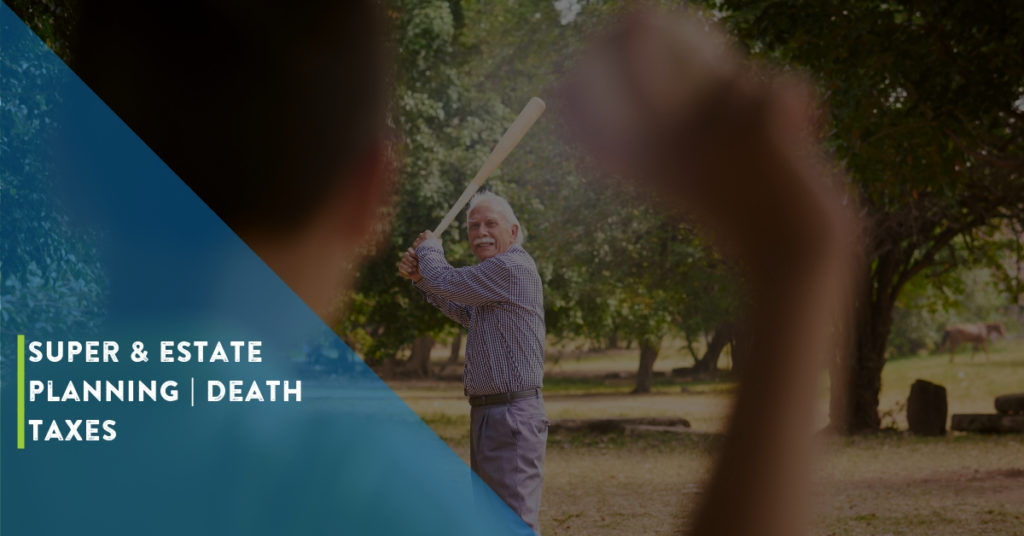
Super|Estate Planning|Hidden Super Death Tax
Ok, so if you have been following the series on getting to know your super better you will now have a better idea about your super. It’s going to be one of your biggest assets, so it’s important you start taking an interest in it, particularly after the revelations coming out from the Royal Commission which is really no surprise to me, but about time it’s front and center.
Here are the links if you have missed the previous posts:-
What is Super? CLICK HERE>>
Tax Effective contributions CLICK HERE>>
Not all super funds are the same CLICK HERE>>
Lump Sum contributions|Downsizing provisions CLICK HERE>>
Investing in super 101 CLICK HERE>>
This week we are going to talk about all things estate planning when it comes to your super. Not many understand the way this works when super is involved however it’s critical to understand and get it right as it could have a significant impact on where your super goes when you die, and it may not be where you want it to go.
We’ll also discuss the little know death tax that relates to super and discuss some strategies to minimise this or completely eliminate these taxes.
I thought my super is part of my will!
This is a common thought among most. The bottom line super generally does not form part of your will and is usually treated separately. Being that super is a tax structure, it treated as a separate entity to your personal assets and investments.
Who can I direct my super to when I die?
The most common nomination is to the surviving spouse where a couple exists. It’s easy and in most cases the simplest and best option. When directed to a spouse or a financial dependent the proceeds are tax-free. This will fall outside of your will.
You have the option, and this happens particularly when you are single, that you can elect to direct your super to your estate via a direction with your super fund.
How do I do this?
The most common way is through completing a death nomination with your super fund.
They generally come in two forms, a binding death benefit nomination which needs to be updated every 3rys or a non-lapsing death benefit nomination which does not need to be updated.
Where these options exist with your super, they are binding on the super fund.
However, where industry funds and some state-based super schemes, you can make a nomination however it is up to the trustee of the super fund to make the final decision. Therefore there is a chance your super could end up in the hands of people you never intended.
What should you do?
Check with your super fund what your current instructions are and if they do not reflect your wishes, have them changed.
The Hidden Death Tax!!!
That’s right, there is the hidden death tax that few are aware of. The common thought out there is if I die their super is tax-free. That is the case if the funds are directed to a spouse or financial dependent. However, that is not the case if the funds are directed to your estate or a non-financial dependent.
How do I tell if there if my Super will need to pay this?
This is determined by your tax components inside your super fund. You will be able to find this information on your most recent super statement.
As you make contributions to your super fund it will be split into two components.
Firstly any contributions your employer makes or you make via salary sacrifice, essentially contributions where tax is paid on the way in, become taxable components.
Where you contribute to super where you are not paying tax on those contributions such as lump sums, they are classed as non-taxable components.
Any growth on your super goes into the taxable bucket.
So, let’s look at an example. Jack, aged 65 has a super fund where his balance is $350,000. Of that, it is broken down into $250,000 taxable and $100,000 non-taxable. If Jack were to pass away and the funds are passed through his estate there would tax of $37,500 payable (15% of the taxable component) prior to the funds being paid to the estate.
Upon converting to an income stream, these components are locked in and convert to a percentage of the balance. As the balance reduces, the taxable component reduces.
Obviously, the bigger the taxable component the larger the tax liability.
Is there a way I can avoid this?
There are a few ways that you can minimise or reduce the tax liability.
When you are closer to retirement you can look to complete what you call a re-contribution strategy. That is you withdraw an amount out of your super fund and re-contribute it back in the form of a lump sum contribution. With the most recent changes to super the government has made it harder to eliminate completely.
Let’s look at Jill. Jill is aged 63 and recently retired. Her super balance is $500,000. That is made up of $400,000 taxable component and $100,000 non-taxable components. Given the new contributions rules, Jill is only allowed to contribute up to $300,000 as a lump sum under the bring forward rules. So, Jill withdraws $300,000 from her super fund and then contributes this $300,000 back into her super fund as a non-concessional contribution.
After making this change, Jill now has $340,000 as a tax-free and $160,000 as a taxable component. At this stage, Jill has reduced her possible death tax by $36,000 just by planning ahead.
Careful planning prior to retirement can help assist minimise this tax and see more flow through to your estate and family members.
Given we don’t know our exact end date is, ensure your Power of Attorneys are well informed. If it happens that you are extremely sick and close to the end your nominated Power of Attorney could possibly instruct your super fund to pay the proceeds out prior to passing. It’s not something that you want to be thinking about, but is something that could save thousands of dollars in tax.
The above will cover around 80% of people’s situations. Given everyone is different it is always advisable to seek advice from a professional.
If you haven’t already downloaded our Start Right Guide to Designed Retirement Lifestyles Guide you can download it by clicking here>>
If you have any questions relating to the above feel free to email me at gdoherty@jigsawprivatewealth.com.au
NEXT STEPS:-
Feel like your confused about how to take control of your money, where to start and how to make it work harder for you? Book a 15 min Fast Track call here>>
We’ll get on the phone for a quick chat and:-
- Have a quick look at the issues you are facing or wanting to address and perhaps a couple you don’t know about.
- Help you diagnose what might be getting in the way.
- Give you clarity about the main actions you should be taking now to get you ahead quicker.
Make it a great Life!
Challenging the Status Quo!
Glenn Doherty – CFP – Founder & Financial Organiser at Jigsaw Private Wealth
Website: jigsawprivatewealth.com.au
Email: gdoherty@jigsawprivatewealth.com.au
Mob: 0401 253 729

